Jacopo de’ Barbari (1440-1516)
Get a Jacopo de’ Barbari (1440-1516) Certificate of Authenticity for your painting (COA) for your Jacopo de’ Barbari (1440-1516) drawing.
For all your Jacopo de’ Barbari (1440-1516) artworks you need a Certificate of Authenticity (COA) in order to sell, to insure or to donate for a tax deduction.
Getting a Jacopo de’ Barbari (1440-1516) Certificate of Authenticity (COA) is easy. Just send us photos and dimensions and tell us what you know about the origin or history of your Jacopo de’ Barbari (1440-1516) painting or drawing.
If you want to sell your Jacopo de’ Barbari (1440-1516) painting or drawing use our selling services. We offer Jacopo de’ Barbari (1440-1516) selling help, selling advice, private treaty sales and full brokerage.
We have been authenticating Jacopo de’ Barbari (1440-1516) and issuing certificates of authenticity since 2002. We are recognized Jacopo de’ Barbari (1440-1516) experts and Jacopo de’ Barbari (1440-1516) certified appraisers. We issue COAs and appraisals for all Jacopo de’ Barbari (1440-1516) artworks.
Our Jacopo de’ Barbari (1440-1516) paintings and drawings authentications are accepted and respected worldwide.
Each COA is backed by in-depth research and analysis authentication reports.
The Jacopo de’ Barbari (1440-1516) certificates of authenticity we issue are based on solid, reliable and fully referenced art investigations, authentication research, analytical work and forensic studies.
We are available to examine your Jacopo de’ Barbari (1440-1516) painting or drawing anywhere in the world.
You will generally receive your certificates of authenticity and authentication report within two weeks. Some complicated cases with difficult to research Jacopo de’ Barbari (1440-1516) paintings or drawings take longer.
Our clients include Jacopo de’ Barbari (1440-1516) collectors, investors, tax authorities, insurance adjusters, appraisers, valuers, auctioneers, Federal agencies and many law firms.
We perform Jacopo de Barbari art authentication, appraisal, certificates of authenticity (COA), analysis, research, scientific tests, full art authentications. We will help you sell your Jacopo de Barbari or we will sell it for you.
Jacopo de Barbari, sometimes known or referred to as: de’Barbari, de Barberi, de Barbari, Barbaro, Barberino, Barbarigo or Barberigo etc., was an Italian painter and printmaker with a highly individual style. He moved from Venice to Germany in 1500, making him the first Italian Renaissance artist of stature to work in Northern Europe. His few surviving paintings (about twelve) include the first known example of trompe l’oeil since antiquity. His twenty-nine engravings and three very large woodcuts had a considerable influence.
His place and date of birth are unknown, but he was described as a Venetian by contemporaries, including Albrecht Dürer (“van Venedig geporn”), and as ‘old and weak’ in 1511, so dates of between 1450 and 1470 have been proposed. Since the earlier part of the range would have him achieve sudden prominence at the age of nearly fifty, the later part would seem more likely. There have also been suggestions he was of German extraction; but it now seems clear he was Italian; there are surviving documents of his in Italian addressed to Germans. He signed most of his engravings with a caduceus, the sign of Mercury, and the Munich still-life (right) with this below his name: “Jac.o de barbarj p 1504” on the painted piece of paper.
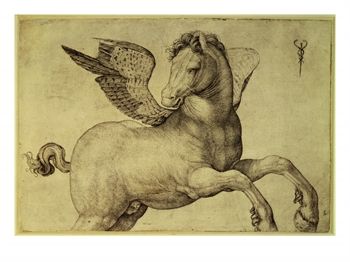
Pegasus Sketch
Nothing is known about his first decades, although Alvise Vivarini has been suggested as his master. He left Venice for Germany in 1500, and thereafter is better documented. There he worked for the Emperor Maximilian I in Nuremberg for a year, then in various places for Frederick the Wise of Saxony in 1503-5, before moving to the court of the Elector Joachim I of Brandenburg for about the years 1506-8. In Germany he was often known as “Jacop Walch”, probably from “Wälsch” meaning foreigner, a term especially used for Italians.
He may have returned to Venice with Philip the Handsome of Burgundy, for whom he later worked in the Netherlands. By March of 1510 he was working for Philip’s successor Archduchess Margaret in Brussels and Malines (Megchelen). In January 1511 he fell ill and made a will, and in March the Archduchess gave him a pension for life, on account of his age and weakness (“debilitation et vieillesse”). By 1516 he had died, leaving the Archduchess in possession of twenty-three engraving plates, which since many of his plates were probably engraved on both sides, means some engravings may not have survived.
His earliest documented work is his huge (1.315 x 2.818 meters, from six blocks) and impressive woodcut aerial view Map of Venice, for which a privilege was granted to its publisher in 1500, recording that the work had taken three years. This clearly drew on the work of many surveyors, but was a spectacular feat nonetheless, and caused a considerable stir from the first. It was later updated by others to reflect major new building projects in a second state of the print.
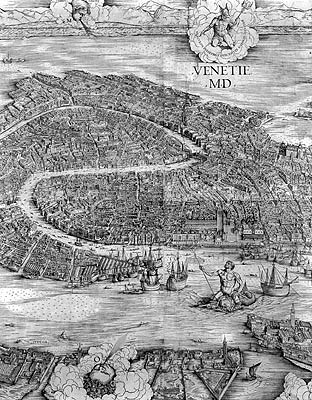
Map of Venice
Apart from the Map of Venice, he produced two other woodcuts, both of men and satyrs, which were the largest and most impressive figurative woodcuts yet produced, and which established the Italian tradition of fine, large, woodcuts for the following decades. These may have also been produced before 1500; they are clearly strongly influenced by Mantegna.
By the time the Map of Venice was published de’ Barberi had already left for Germany, where he met Dürer, who he may have already known from Dürer’s first Italian trip (a passage in a letter of Dürer’s is ambiguous). They discussed human proportion, not obviously one of de’ Barberi’s strengths, but Dürer was evidently fascinated by what he had to say, though he recorded that de’ Barberi had not told him everything he knew:
…I find no one who has written anything about how to make canon of human proportions except for a man named Jacob, born in Venice and a charming painter. He showed me a man and a woman which he had made according to measure, so that I would now rather see what he meant than behold a new kingdom… Jacobus did not want to show his principles to me clearly, that I saw well.” (from an unpublished draft of the Introduction to Dürer’s own book on human proportions).
Twenty years later Dürer tried unsuccessfully to get the Archduchess Margaret, Hapsburg Regent of the Netherlands, to give him a manuscript book she had on the subject by de’ Barberi, by then dead; the book has not survived.
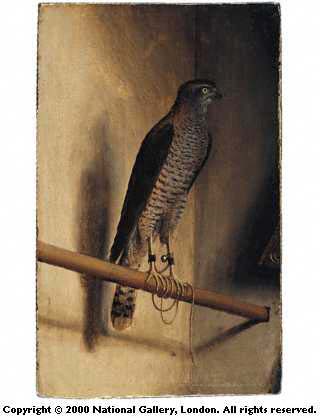
A Sparrowhawk
De’ Barberi spent a year in Nuremberg, where Dürer lived, in 1500-01, and influences flowed in both directions between him and Dürer for a number of years. None of his engravings are dated, so much of the dating of them depends on resemblances to dated prints by Dürer; this is complicated by uncertainty in some cases as to who was influencing who. Five of his engravings were in an album of Hartmann Schedel’s , which was bound up in December 1504, which gives further evidence as to dating. De’ Barberi had probably made some engravings before leaving Italy, but his best engravings (and perhaps all of them) were probably done after his move to Germany in 1500.
Some of his paintings are dated as: 1500, 1503, 1504, 1508. Documents relating to his employment by Maximilian suggest his work was to include illuminating manuscripts, but no work in this medium has been generally attributed to him. His only generally accepted drawing is a Cleopatra in the British Museum, apparently done as a study for an engraving which has not survived.
His style is related to his possible master, Alvise Vivarini and to Giovanni Bellini, but has a languorous quality all its own. Apart from Dürer, the influence of Mantegna’s technique also appears in what are probably the earlier engravings, done around the turn of the century, with parallel hatching. His engravings are mostly small, showing just a few figures. Truculent satyrs feature in several prints; there are a number of mythological subjects, including two Sacrifices to Priapus.
The earlier prints show figures with “small heads and somewhat shapeless bodies, with sloping shoulders and thick torsos supported by slender legs” — also seen in his paintings. Probably from a middle period come several nudes, the most famous being Apollo and Diana, St Sebastian and the Three Bound Captives. In these his ability to organize the whole composition has greatly improved.
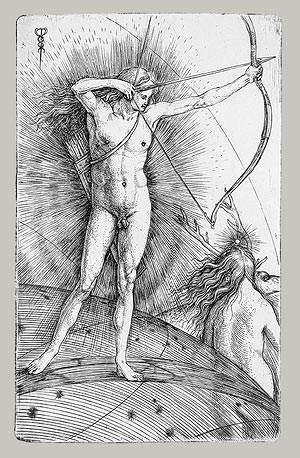
Apollo and Diana, Engraving 1500-1505
In a final group, the style becomes more Italianate, and the compositions more complex. These have an enigmatic, haunting atmosphere, and a very refined technique. Levenson has proposed that they date from his period in the Netherlands and were influenced by the young Lucas van Leyden.
His paintings are mostly portraits or half-length groups of religious figures. He painted a live Sparrowhawk (National Gallery, London), which is probably a fragment of a larger work. The very early still-life of a Partridge, gauntlets, and crossbow bolt (Alte Pinakothek, Munich) is also the first small scale trompe l’oeil painting since antiquity; it may well have been the cover or reverse of a portrait. In the Gemäldegalerie, Berlin there is a Portrait of a German Man and a religious subject. The Louvre has a religious group, and Philadelphia a pair of figures.
A disputed but famous work, the Portrait of Fra Luca Pacioli and his student, Guidobaldo da Montefeltro, Duke of Urbino is in the Museo di Capodimonte in Naples. This shows the Franciscan mathmetician and expert on perspective demonstrating geometry at a table on which lie his own Summa and a work by Euclid. His exquisitely dressed pupil ignores this and looks out at the viewer. The work is signed “IACO. BAR VIGEN/NIS 1495”.
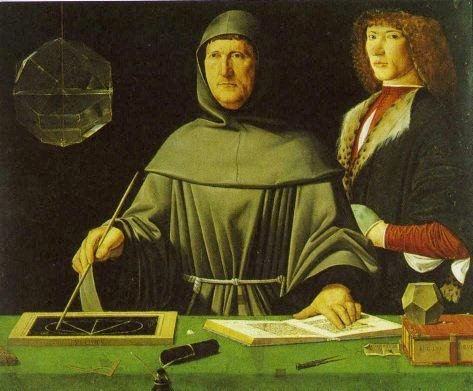
Luca Pacioli, 1495
Reviews
1,217 global ratings
5 Star
4 Star
3 Star
2 Star
1 Star
Your evaluation is very important to us. Thank you.
